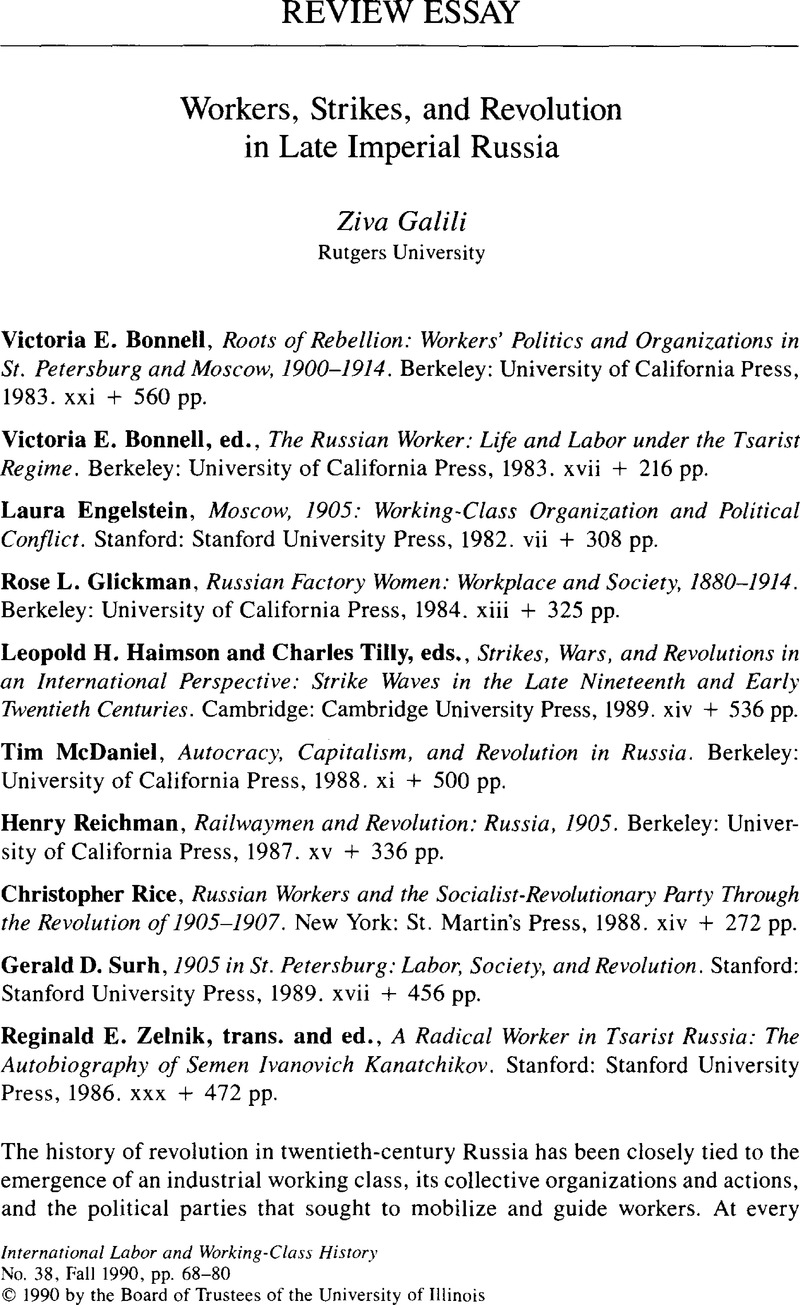No CrossRef data available.
Published online by Cambridge University Press: 16 December 2008

1. See especially Galili, Ziva, The Menshevik Leaders in the Russian Revolution: Social Realities and Political Strategies (Princeton, 1989)Google Scholar; Koenker, Diane and Rosenberg, William G., Strikes and Revolution in Russia, 1917 (Princeton, 1989)Google Scholar; Mandel, David M., The Petrograd Workers and the Fall of the Old Regime (New York, 1983)CrossRefGoogle Scholar; idem, The Petrograd Workers and the Soviet Seizure of Power (New York, 1984)Google Scholar; Smith, S. A., Red Petrograd, Revolution in the Factories, 1917–1918 (Cambridge, 1983).CrossRefGoogle Scholar
2. Zelnik, Reginald, “Russian Bebels: An Introduction to the Memoirs of Semen Kanatchikov and Matvei Fisher,” The Russian Review 35 (07 1976): 249–89; 36 (10 1976): 417–47.CrossRefGoogle Scholar
3. The only work in this area to precede Zelnik's was Alan Wildman's seminal study of the interactions between social democrats and workers in the pre-1905 labor movement, The Making of a Worker's Revolution: Russian Social Democracy, 1891–1903 (Chicago, 1967).Google Scholar Two other works have touched on the subject at least tangentially: Sablinsky, Walter, The Road to Bloody Sunday (Princeton, 1976)Google Scholar, and Schwartz, Solomon M., The Russian Revolution of 1905: The Workers' Movement and the Formation of Bolshevism and Menshevism (Chicago, 1967).Google Scholar
4. See Bater, James H., St. Petersburg: Industrialization and Change (London, 1976)CrossRefGoogle Scholar; Bradley, Joseph, Muzhik and Muscovite: Urbanization in Late Imperial Russia (Berkeley, 1985)Google Scholar; and Johnson, Robert Eugene, Peasant and Proletarian: The Working Class of Moscow in the Late Nineteenth Century (New Brunswick, 1979).Google Scholar
5. Haimson pursued this point in much greater detail in an article he co-authored with Brian, Eric, “Changements demographiques et grèves ouvrières à Saint-Petersbourg, 1905–1914,” Annales ECC (07–10 1985): 781–803.Google Scholar
6. Haimson, , “The Problem of Social Stability in Urban Russia, 1905–1917,” Slavic Review 23 (12 1964): 619–42; 24 (03 1965): 1–22.CrossRefGoogle Scholar
7. Haimson, Leopold H. and Brian, Eric, “Three Strike Waves in Imperial Russia (1906–7, 1912–14, 1915–16): Findings and Interpretations of a Comparative and Quantitative Analysis,” in Haimson, and Capelli, Julio, eds., Strikes, Wars, and Revolution in an International Perspective: The Impact of the War Experience, 1914–1918 (Milan, forthcoming).CrossRefGoogle Scholar
8. A partial exception is found in the early chapters of Suny, Ronald G., The Baku Commune, 1917–1918: Class and Nationality in the Russian Revolution (Princeton, 1972).Google Scholar
9. Zelnik's, Reginald E. work is an important exception, especially his Labor and Society in Tsarist Russia: The Factory Workers of St. Petersburg, 1855–1870 (Stanford, 1971).Google Scholar
10. This point was evident in a series of international conferences on strikes and revolutionary situations during and after World War I, the results of which are summarized in the Haimson and Tilly volume reviewed here and in the forthcoming volume edited by Haimson and Capelli (see note 7 above).